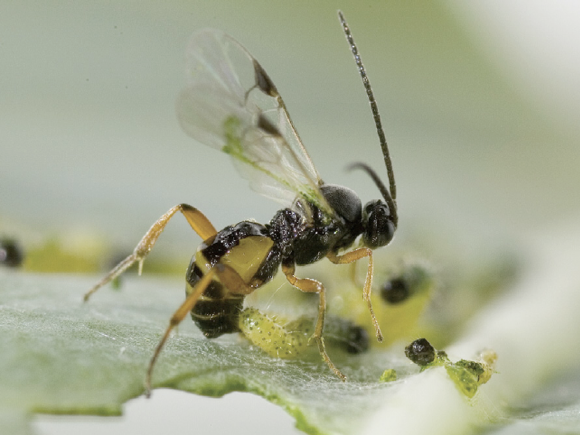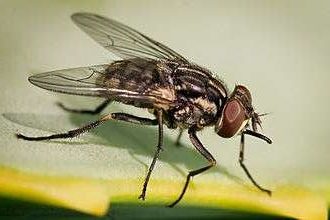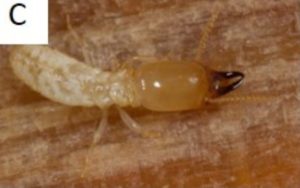By Pascal ROUSSE
Do you know what a parasitoid is? If so, you also know how fascinating their life cycle is. If not, you will soon know thanks to this detailed example.
A paper written by the specialist Pascal Rousse for Passion-Entomologie, a big thank you to the author for agreeing to share his passion for these amazing insects. Find the author’s presentation in the middle of the article.
Let’s start with a definition by simplifying a bit and following the notes for those who like precision. A parasitoid is an insect (1) whose juvenile stages will develop on, or in another animal called host (2). Unlike parasites, parasitoids must kill their host to complete their development. On the contrary, if a parasite such as a louse, tapeworm or moat causes the death of its permanent host, it dies with it.
The example illustrated here is that of a parasitoid called”koïnobionte“, a parasitoid that keeps its host alive and manipulates its physiology to ensure the development of its own offspring. The host is killed only at the final stage of parasitoid development. In this type of long interaction, the parasitoid slowly nibbles at its host from within, while knowingly sparing its vital organs and playing hide and seek with its immune system. And he will sometimes go so far as to make the dying host the bodyguard of his torturers.
caption id=”attachment_3625″ align=”alignright” width=”340″] Adult female of C. glomerata parasitizing a first instar caterpillar of P. brassicae on a cabbage leaf (Source : Hans Smids)[/caption]
Adult female of C. glomerata parasitizing a first instar caterpillar of P. brassicae on a cabbage leaf (Source : Hans Smids)[/caption]
Let’s start with a chronological presentation of the actors. At the beginning, there is a cabbage, Brassica oleracea. This cabbage whets the appetite of a caterpillar, the well named cabbage pieride Pieris brassicae. But this piéride is itself coveted by a parasitoid called Cotesia glomerata (3). The photo opposite shows how a female of C. glomerata injects its eggs inside the body of a first stage caterpillar, using the ovipositor located at the end of its abdomen and which works like a syringe. From that moment on, the caterpillar is doomed. Slowly, but irremediably condemned.
The sequel is superbly staged in this video of National Geographic (see also at the bottom of the page). The young caterpillars have continued their own development, eating cabbage leaves and storing reserves that will be useful for the parasitoid. Later, when they complete their larval development, the larvae of C. glomerata pierce the caterpillar cuticle with their mandibles and then pupate outside. Curiously, the caterpillar seems almost indifferent to this multiple emergence, even though it is very much alive, as the following shows: not only does it weave a protective cocoon around the parasitoid’s nymphs, but it also protects them with violent jolts against new arrivals who seem interested in the scene. What’s going on?
These newcomers are what we call hyperparasitoids (4) : parasitoids whose host is itself a parasitoid. It’s a trophic chain with drawers that ultimately involves four actors. For C. glomerata, the challenges to be taken up in order to guarantee the survival of his descendants are multiple. First, the adult female must locate a caterpillar, make sure that it can ensure the development of its offspring and then lay its eggs inside. Then, these eggs hatch into larvae that must survive the caterpillar’s immune system, and kill the caterpillar neither too early nor too late for it to heel and cover them and then defend them. If all goes well, a new generation of C. glomerata adults may emerge from the cocoon cluster ( photo opposite), then resume the cycle. In this theatre we will now be able to see the extreme finesse of what can give birth to the interspecificco-evolution (another example to discover between ants and a fungus fungal ants).
caption id=”attachment_3697″ align=”alignleft” width=”350″] Emergence of a new generation of adult C. glomerata. Note the dried remains of the caterpillar on which the adult exit holes of C. glomerata can be distinguished in the silky cluster of protected cocoons (white arrows), and the mating of the parasitoid that occurred immediately after emergence (red arrow) (Source : H. Dumas)[/caption]
Emergence of a new generation of adult C. glomerata. Note the dried remains of the caterpillar on which the adult exit holes of C. glomerata can be distinguished in the silky cluster of protected cocoons (white arrows), and the mating of the parasitoid that occurred immediately after emergence (red arrow) (Source : H. Dumas)[/caption]
Because all these challenges are overcome by the reception and emission of chemical mediators. Thus, the female of C. glomerata locates host larvae by smell. Not directly the smell of the caterpillars themselves, but rather that of the attacked leaf. Firstly because this smell is more abundant and therefore easier to detect in the environment, but also because the cabbage itself has a certain interest in attracting caterpillar enemies ! This has been demonstrated by multiple experiments: females of C. glomerata react to the smell of caterpillars, to the smell of a healthy cabbage leaf or to an artificially damaged cabbage leaf, but they respond even more to a cabbage leaf that has been partly nibbled by P caterpillars. brassicae. Even stronger: they will react only slightly to the smell of a leaf nibbled by fifth-stage caterpillars, largely preferring leaves with first-stage larvae. In short, this means that, by smell alone, a female of C. glomerata will remotely locate a cabbage leaf attacked by caterpillars of adequate age. It was determined that the molecular composition of the odour emitted by the cabbage leaves is modified by the attack of the caterpillars, including the highly attractive molecules for the parasitoid, which constitutes a kind of alarm signal emitted by the plant to the parasitoid.
 Presentation of the author Entomologist researcher, correspondent of the Muséum National d’Histoire Naturelle de Paris (MNHN), versed in the taxonomy, ecology and phylogeny of parasitoid hymenoptera, particularly in their use in biological control, author of about thirty publications on these subjects, but above all long fascinated by the biology of Ichneumonidae without psychoanalysis having been able to find a rational explanation to this monomania ! |
Continue the investigation inside the caterpillar body. All insects are equipped like us with an immune system based on the recognition and elimination of the “non-self”. If you are having fun introducing a foreign body into a P caterpillar. brassicae, this body will quickly be enysté in a mixed capsule. However, this immune system remains silent in the case of parasitism by C. glomerata. Parasitoid larvae are active and unharmed in the caterpillar body, invisible to the immune cells of the infested host.
Always more surprising, the whole behaviour and subsequent development of the caterpillar is modified by parasitism. Thus, the caterpillar is paralysed when the larvae emerge, whereas it could defend itself thanks to its mandibles. Thus again, the caterpillar weaves a silk cocoon around the parasitoid nymphs. And finally, the caterpillar responds aggressively when it is disturbed in the last moments of its life. The latter two behaviours have been shown to effectively protect parasitoid cocoons from predators and hyperparasitoids that may approach them.
There again, the reason is chemical interaction, although these mechanisms are not yet fully elucidated. What is known is that when the female parasitoid injects her eggs, she also injects a cocktail of proteins called “venom” by analogy to that of bees and wasps, and that she also injects very particular viruses. The action of the whole is determining in the weakening of the immune response, it is also assumed that its interaction with the brain of the caterpillar is responsible for the modification of its behavior. The evolution of these viruses alone is a fascinating story. They consist of several DNA strands that are fully integrated into the parasitoid genome. What gives them such a special character that virologists have created a family apart for them: the family of Bracovirus.
You have now understood where James Cameron’s inspiration came from when he directed his film “Alien” ?
Videos of parasitoid development cycle
Notes
- Following the exact limits set in the definition, we can also include other living organisms (5), a few rare cases found for example in nematodes or fungi
- Another arthropod (insect or spider) in the overwhelming majority of cases. But here again everything depends on the limits of the initial definition
- A Hymenoptera of the family Braconidae, subfamily Micrograstinae. Micrograstinae are all butterfly parasitoids
- Probably Lysibia nana, Hymenoptera Ichneumonidae parasitoid of many Micrograstinae
- In fact, is a virus a living organism? If we decide yes, then we can also call it a parasitoid. But this is another debate…
For more information
– Brodeur J. & Vet L.E.M. (1994) : Usurpation of host behavior by a parasitic wasp. Animal Behavior 48, 187-192
– Dicke M. (1993) : Local and systemic production of volatile herbivore-induced terpenoids : their role in plant-carnivore mutualism. Journal of Plant Physiology 143, 465-472
– Madanagopal N. & Kim Y. (2006) : Parasitism by Cotesia glomerata induces immunosuppression of Pieris rapae : effects of ovarian and polydnavirus. Journal of Asia-Pacific Entomology 9, 339-346
– Mattiaci L. & Dicke M. (1995) : Host-age discrimination during host location by Cotesia glomerata, a larval parasitoid of Pieris brassicae. Entomologia Experimentalis and Applicata 76, 37-48
– Maure F. ; Daoust S.P. Brodeur J.; Mitta G. & Thomas F. (2013) : Diversity and evolution of bodyguard manipulation. The Journal of Experimental Biology 216, 36-42
– Steinberg S. ; Dicke M. & Vet L.E.M. (1993) : Relative importance of info chemicals from first and second trophic level in long-range host location by the larval parasitoid Cotesia glomerata. Journal of Chemical Ecology 19, 47-59
strong>Recommendations of works on this theme :
>”text-decoration : underline ;”>Recommandations d’ouvrages sur cette thématique >
– Interactions insectes-plantesimg style=”border : none !important ; marge : 0px !important ;” src=”http://ir-fr.amazon-adsystem.com/e/ir ?”.t=passioentomo-21&l=as2&o=8&a=2759220184″ alt=””” width=”1″ height=”1″ height=”1″ border=”0″ /> (N. Sauvion ; P.A. Calatayud ; D. Thiery & ; F. Marion-Poll – Editions Quae – 750 pages – 5 septembre 2013)strong>>>/>. La lutte biologique.. : Application aux arthropodes ravageurs et aux adventices (Bernard Pintureau – Editions ….) Ellipses Marketing – 188 pages – 25 avril 2009)em>
>>>.
– La lutte biologique au jardin (Vincent Albouy – Editions : Quae Editions – 102 pages – 10 mars 2012)/p>>.
– Insect-Plant Biologyimg style=”border : none !important ; marge : 0px !!important ;” src=”http://ir-fr.amazon-adsystem.com/e/ir ?t=passioentomo-21&l=as2&o=8&a=0198525958″ alt=”” width=”1″ height=”1″ height=”1″ border=”0″ /> (Louis M. Schoonhoven, Joop J.A. van Loon & ; Marcel Dick – Editions …) OUP Oxford – 448 pages – 1 décembre 2005)
>>.
– The Braconid and Ichneumonid Parasitoid Wasps : Biologie, systématique, évolution et écologie (Donald L.J. Quicke – Editions… : Wiley-Blackwell – 704 pages – 1 décembre 2014)
>>.





